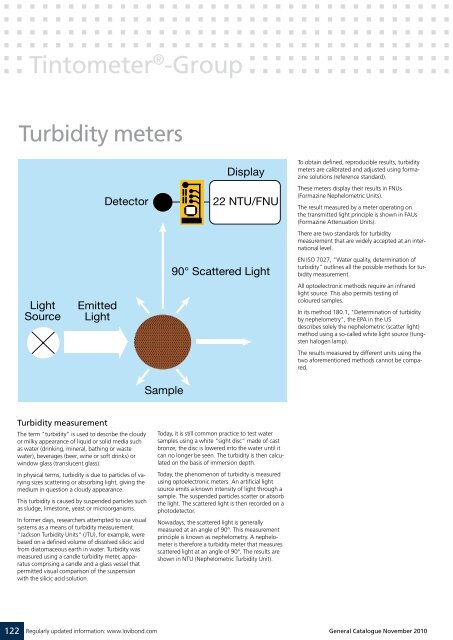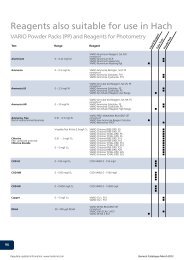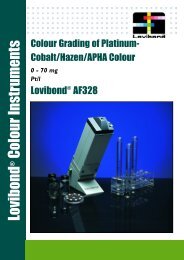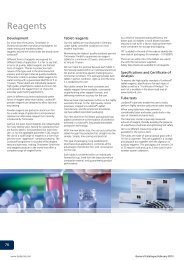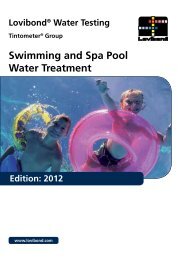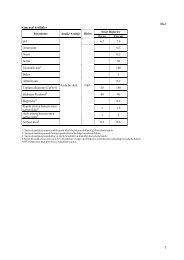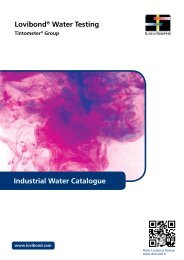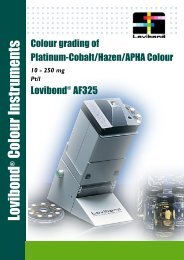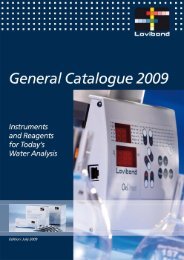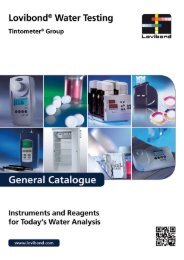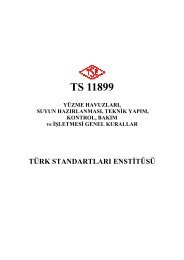General Catalogue
General Catalogue
General Catalogue
- No tags were found...
You also want an ePaper? Increase the reach of your titles
YUMPU automatically turns print PDFs into web optimized ePapers that Google loves.
Tintometer ® -GroupTurbidity metersTo obtain defined, reproducible results, turbiditymeters are calibrated and adjusted using formazinesolutions (reference standard).These meters display their results in FNUs(Formazine Nephelometric Units).The result measured by a meter operating onthe transmitted light principle is shown in FAUs(Formazine Attenuation Units).There are two standards for turbiditymeasurement that are widely accepted at an internationallevel.EN ISO 7027, "Water quality, determination ofturbidity” outlines all the possible methods for turbiditymeasurement.All optoelectronic methods require an infraredlight source. This also permits testing ofcoloured samples.In its method 180.1, "Determination of turbidityby nephelometry", the EPA in the USdescribes solely the nephelometric (scatter light)method using a so-called white light source (tungstenhalogen lamp).The results measured by different units using thetwo aforementioned methods cannot be compared.Turbidity measurementThe term "turbidity” is used to describe the cloudyor milky appearance of liquid or solid media suchas water (drinking, mineral, bathing or wastewater), beverages (beer, wine or soft drinks) orwindow glass (translucent glass).In physical terms, turbidity is due to particles of varyingsizes scattering or absorbing light, giving themedium in question a cloudy appearance.This turbidity is caused by suspended particles suchas sludge, limestone, yeast or microorganisms.In former days, researchers attempted to use visualsystems as a means of turbidity measurement."Jackson Turbidity Units" (JTU), for example, werebased on a defined volume of dissolved silicic acidfrom diatomaceous earth in water. Turbidity wasmeasured using a candle turbidity meter, apparatuscomprising a candle and a glass vessel thatpermitted visual comparison of the suspensionwith the silicic acid solution.Today, it is still common practice to test watersamples using a white "sight disc” made of castbronze; the disc is lowered into the water until itcan no longer be seen. The turbidity is then calculatedon the basis of immersion depth.Today, the phenomenon of turbidity is measuredusing optoelectronic meters. An artificial lightsource emits a known intensity of light through asample. The suspended particles scatter or absorbthe light. The scattered light is then recorded on aphotodetector.Nowadays, the scattered light is generallymeasured at an angle of 90°. This measurementprinciple is known as nephelometry. A nephelometeris therefore a turbidity meter that measuresscattered light at an angle of 90°. The results areshown in NTU (Nephelometric Turbidity Unit).122 Regularly updated information: www.lovibond.com <strong>General</strong> <strong>Catalogue</strong> November 2010


